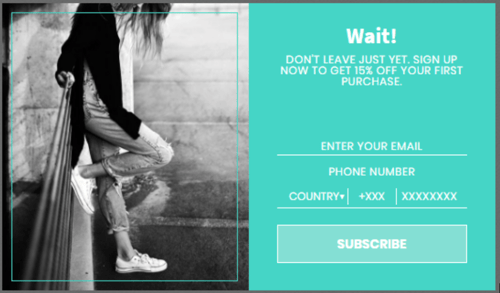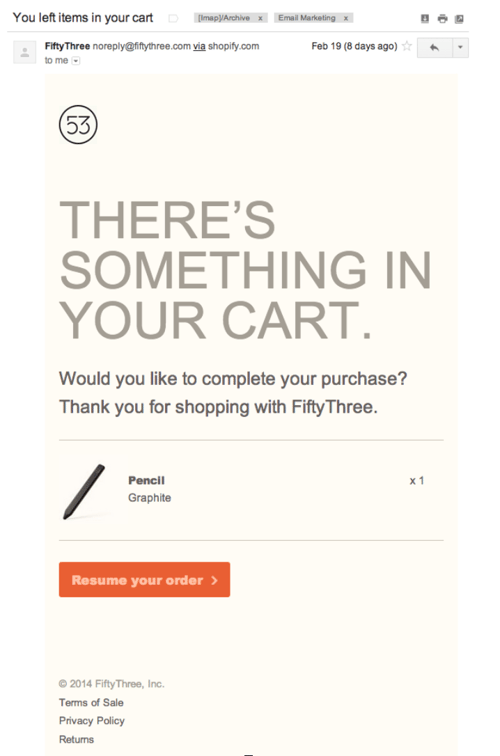- Learning Center
- Small Business Blog
- Business Marketing
- 4 Must-Have Email Marketing Automation Strategies for Ecommerce
If you are a small business owner, take note – email marketing automation is one of the most important tools for eCommerce, and is worth investing time in.
Why? Well, the answer is quite simple – it saves a ton of time and allows for segmentation of your audience and personalized content.
With a highly relevant message, customers are more likely to open their emails more often, visit your eCommerce store, and drive up revenue!
However, as with any other important task, you need a strategy, and below are 4 must-have email marketing automation strategies for eCommerce.
1. Create a subscription form for email capture
Your ecommerce store simply must have a subscription form, it’s where user journey begins. Make sure it is located somewhere on your landing page, so that visitors can find and complete it at ease.

Avoid including as many fields in the form as possible (to collect all the info about the potential client).
Keep it brief and simple, let them fill in their name and email address. You will have lots of opportunities to collect more info later on through other means as you build your relationship with your customer.
Here is a great example of very basic subscription form as a popup.
As a small business owner, you should know by heart that email marketing for eCommerce is like salt for cooking – they are inseparable.
It is highly important to collect emails since you will be able to reach even those visitors who haven’t bought anything from you. Yet.
2. Create a welcome email series to bring customers into the fold
Okay, so you’ve collected your subscribers list, now what?
Act quickly and start building your relationship with the potential customers. An automated welcome email is the perfect way to start communicating.
As a business owner you must know that the first impression is everything when the customer steps over your brick-and-mortar shop’s doorstep - the same applies for ecommerce and your first email is your way of introducing the customer to your brand.
Obviously, you can do it manually, but you’d never have time to do anything else. By automating your welcome emails, they’ll always be sent in a timely manner, with the same content, and you don’t need to waste your time on this mechanical task.
To create an automated welcome email, simply set up a rule that once the visitor enters their email address into your subscription form, they’ll receive a pre-created welcome email in a few moments.
What’s even better is personalizing this email with that particular user’s name, so that it creates a sense of 1 on 1 communication that can increase engagement.
As a business owner, this an opportunity you must not miss.
3. Find the right timing for email marketing
Depending on the product you sell, the majority of shoppers across the globe are known to be ‘high-frequency’ shoppers, which is especially noticeable around certain holidays throughout the year.
For example, customers who might shop from time to time will likely be shopping more frequently around key holidays, like Valentine’s day, or Black Friday. Therefore, it’s important to think about your promotions throughout the year, and have a plan in place. During such times as Black Friday Weekend, Christmas Eve, Valentine’s Day, Mother’s Day, and so on, it’s all about timing, efficiency, and effectiveness of your email marketing campaign.
The result in email traffic during these times is at 3 times the normal average, so you can imagine how fierce the competition is and how important it is to stand out and send your emails at the right time, to the right person, with the right content.
4. Set up cart abandonment recovery campaigns
Last, but definitely not least is the recovery of customers’ abandoned carts.
As an eCommerce owner, you probably know how important and effective it is to remind your customers about their abandoned products.
It is actually estimated that nearly 70% of carts never see the checkout page, and there are plenty of reasons for that.
Regardless of why the customer has left his items in the basket and never bought them, your goal is to remind them about why they fell in love with the product in the first place, and encourage to continue shopping.
All you need to do is the following:
- Capture the customer’s email.
- Collect data of his purchasing preferences and what’s left in his/her basket.
- Set up abandoned cart recovery emails to bring the customer back to their cart.
The most effective way of doing the third task is to send the email within the first 24 hours after the customer has abandoned the cart.
A good strategy is to create an email cart recovery series, starting within an hour of the cart being abandoned, with the first follow up being sent 12 hours after. The third follow up should come 24 hours after the cart was abandoned.
There are tons of ways to create a great email marketing automation strategy for your online store. While these examples were some of the most popular methods, it’s important to try out new things and create custom automation workflows too.
After all, what works for one eCommerce site won’t necessarily work for another. It’s important to test everything to find what works best for you and your customers.







